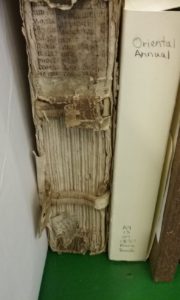The ties that bind: How the decay of a binding shows its construction
Swem Library has a great many books in very bad bindings. Most modern books, for instance, are held together only by glue at the spine. Even modern hardcovers have the same binding. Other than the hard shell surrounding them, they are in all other respects exactly the same as a cheap paperback. In the past, however, bindings were much stronger.
Special Collections also has books that have bad bindings, but in many cases their poor condition is due to the fact they are old enough to have been damaged by time or handling. One example shows how this process happens, and also the way the book was made over five hundred years ago, in 1498. Even if the binding is in trouble now, five centuries is not a bad run.
The bumps on the spine of an old book are not just decorative. They are cords, and the pages are sewn to them, so that they are actually integral to the structure. Here they are made of animal skin. The spine was also backed with another piece of animal skin, or in this case, an old manuscript. Many medieval manuscripts ended up this way, cut to bind the products of the printing press which was changing the way books were made. Traces of the manuscript are still visible here because the outer layer of binding has worn away over the centuries. The text you can see here is neither printed, nor was it added after the book was made. It is a medieval manuscript, re-purposed.
The other parts of a hardback that you may be familiar with, but that have lost its original purpose, are the headbands. These are the little pieces of coloured thread at the top and bottom of the spine, which originally reinforced it during use and particularly during removal from the shelf. Modern headbands are just glued on to the spine. In the past, however, they were sewn to the binding before the outer skin was added. Here again you can see how this book is coming apart, but also that the headbands have come loose (and this one has split), and that they are clearly made up of thread that also loops down, through the vellum manuscript, where they are anchored to the structure of the book.

Although we might wish that this binding was still intact, protecting this book from 1498, its decay provides great lessons in how books were made when they were really built to last.



